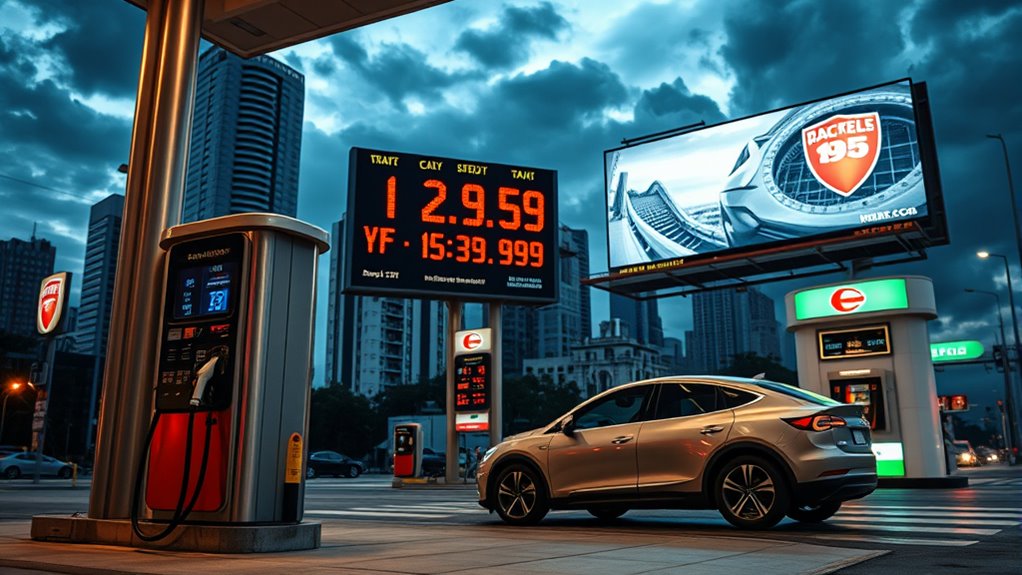Gas prices in 2025 stay high due to ongoing geopolitical tensions, supply restrictions, and regional regulations. Global conflicts and instability in oil-producing areas keep supplies tight, while local taxes and environmental rules raise costs further. Although demand is gradually decreasing thanks to energy shifts, prices remain elevated because of inflation and market uncertainties. If you want to understand the full picture behind these costs, there’s more to uncover about the factors influencing prices this year.
Key Takeaways
- Global oil supply disruptions and geopolitical conflicts are constraining supply, driving prices higher.
- Regional regulations, taxes, and transportation costs contribute to higher local gasoline prices.
- Increased energy transition efforts and slower adoption of electric vehicles maintain demand for gasoline.
- Market uncertainties and geopolitical tensions sustain elevated prices despite slight decreases.
- Inflation and economic factors create a price floor, preventing significant declines in gas prices.

Have gas prices in 2025 met your expectations? If you’re wondering why fuel costs remain relatively high despite recent declines, it’s important to understand the underlying factors. Gas prices in 2025 are influenced by a complex mix of global supply, regional demand, geopolitical events, and technological shifts. While the national average has dropped to around $3.15 per gallon, regional disparities remain, with the West Coast topping at $4.23. The overall trend shows prices decreasing slightly from April to May, but forecasts suggest they’ll hover around $3.22 for the year.
Gas prices in 2025 hover around $3.15, with regional disparities and global factors influencing the trend.
One key reason for these ongoing high prices is the global oil supply. Since 2022, abundant supplies and increased U.S. oil production have helped push prices down from their previous peaks. However, the supply isn’t enough to fully offset regional demand variations or geopolitical disruptions. International conflicts, trade sanctions, and instability in major oil-producing regions can suddenly tighten supplies, leading to price spikes. These international factors make gasoline more expensive, regardless of local production increases. Global supply dynamics also play a crucial role in determining prices, as fluctuations in worldwide oil inventories directly impact market stability.
The rise of electric vehicles and renewable energy sources also plays a role in shaping the market. As more consumers switch to electric vehicles, the demand for gasoline is expected to decline over time. This shift encourages refiners and oil producers to adjust, but the transition isn’t immediate or uniform across regions. In the meantime, traditional fuel remains essential, especially in areas where electric infrastructure is less developed. The continued reliance on gasoline, combined with global supply pressures, sustains higher prices. Additionally, energy transition initiatives are gradually influencing market dynamics and future price trends.
Regional variations are significant. The West Coast’s high prices reflect local taxes, stricter environmental regulations, and transportation costs. Conversely, the Lower Atlantic region enjoys lower average prices, around $2.91, partly because of less regulation and proximity to oil sources. These differences highlight how regional demand and policy influence prices directly. Understanding these regional factors can help consumers better plan their fuel expenses and consider alternative transportation methods.
Looking ahead, analysts expect prices to stay relatively high through 2025, with December’s average projected around $2.89. Despite the overall decline from previous years, economic factors like inflation and interest rates keep a floor under prices. Meanwhile, technological advances, such as renewable energy and electric vehicles, are gradually reducing dependence on gasoline, which might eventually lead to lower prices. For now, though, geopolitical uncertainties and supply-demand balances keep gas prices elevated, making it essential for consumers to think about alternative transportation options and energy sources in their planning.
Frequently Asked Questions
How Do Geopolitical Tensions Specifically Impact Fuel Costs?
Geopolitical tensions impact your fuel costs mainly through disruptions in OPEC production and the supply chain. When conflicts or sanctions occur, oil supply decreases, causing prices to rise. Traders anticipate these disruptions, leading to market volatility. As a result, fuel becomes more expensive because reduced OPEC output and supply chain issues limit availability, pushing prices higher and making it costlier for you at the pump.
What Role Do Renewable Energy Policies Play in Gas Prices?
Think of the energy market as a dance floor. When renewable subsidies and policy incentives shift, the rhythm changes. If renewables lose support, the dance slows, and more folks turn to gas, raising prices. Conversely, strong policies for renewables can lead to less reliance on gas, lowering costs. Your choices in renewable policies set the tempo, directly influencing gas prices in this complex dance.
Are There Regional Differences in Gas Price Fluctuations?
You’ll notice regional disparities in gas price fluctuations because local factors influence price variation. In Mississippi, prices stay relatively low due to nearby refineries and low fuel taxes. Meanwhile, California faces higher costs from strict regulations and hefty taxes. Supply disruptions, refinery capacity, and demand also cause regional shifts, making prices more volatile in some areas. These regional differences show how local policies, infrastructure, and demand drive distinct gas price patterns across the country.
How Does Currency Exchange Rate Volatility Affect Fuel Prices?
It’s ironic how currency stability can make or break your fuel costs. When exchange rates fluctuate wildly, your local fuel prices can spike unexpectedly, even if global oil prices stay steady. If your currency weakens against the USD, you’ll pay more for imports. Stable exchange rates, on the other hand, protect you from sudden price swings, keeping fuel costs predictable—though that’s often just wishful thinking in today’s volatile markets.
Will Future Technological Advances Lower Gas Prices?
You might wonder if future technological advances will lower gas prices. With increased electric vehicle adoption, demand for gasoline could decrease, putting downward pressure on prices. Oil exploration innovations, like AI-driven reservoir modeling and IoT monitoring, boost extraction efficiency and reduce costs. These improvements may lead to more affordable fuel, but market factors and policy changes also influence prices, so the impact isn’t guaranteed.
Conclusion
So, next time you hit the pump and wonder why gas costs so much in 2025, remember that it’s not just random. Some say a secret global energy cartel is controlling prices, while others believe it’s all about supply and demand swings. Whether true or not, it’s clear that a mix of geopolitics, market shifts, and environmental policies is fueling these prices. Stay informed, and maybe someday, we’ll see prices drop again.










